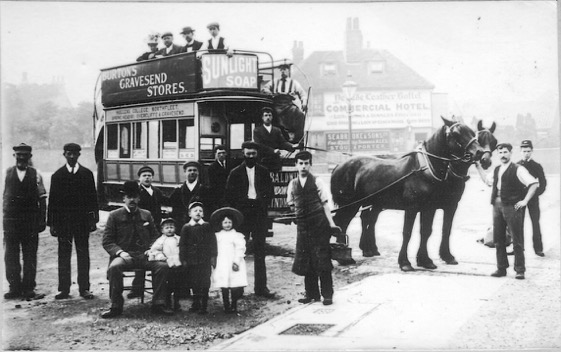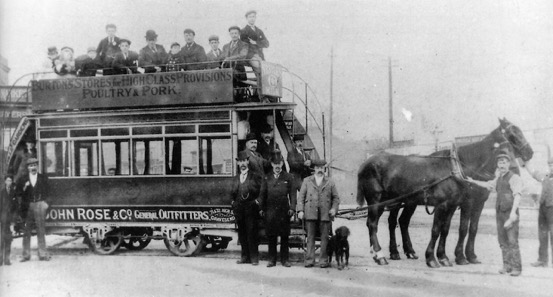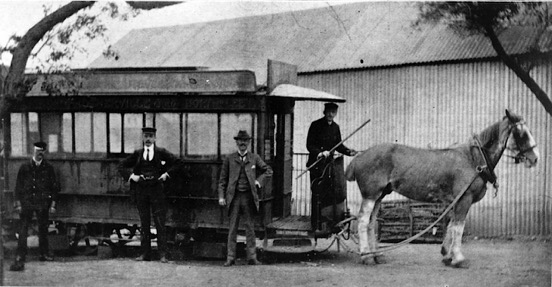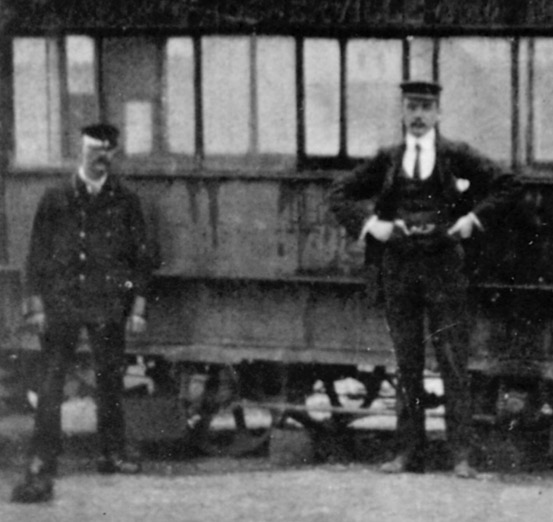Gravesend, Rosherville and Northfleet Tramways
History
Powers for a short, 3ft 6ins-gauge horse tramway, between Gravesend and Northfleet, were granted on the 18th July 1881 under the Gravesend, Rosherville and Northfleet Tramways Order, 1881, which was authorised under the umbrella of the Tramways Orders Confirmation (No. 3) Act, 1881. The order allowed only 18 months for completion, so the company must have received the sanction of the Board of Trade for a short extension of the time allowed, as the first section, between Gravesend and the 'Leather Bottel' pub in Northfleet, did not open until the 11th June 1883.
Although some histories state that permission for the remaining section of the line — westwards to a terminus outside Huggens College in High Street — was refused, this is not borne out by the enabling legislation, which authorised the full route. Given that the company struggled to build the line between Gravesend and the 'Leather Bottel' in the time allowed, it seems more likely that it simply didn't have the financial wherewithal to build the full tramway.
With the powers for the extension westwards having lapsed, the company now returned to parliament to seek authorisation for the missing 0.6 miles, though this time, it also requested powers to use mechanical traction. These powers were granted on the 14th July 1884 by the Gravesend, Rosherville and Northfleet Tramways (Extension) Order, 1884, under the umbrella of the Tramways Orders Confirmation (No. 4) Act, 1884.
Here matters rested once again, which tends to suggest that the company lacked the capital to begin construction. Salvation eventually arrived in the form of the Series Electric Traction Syndicate Limited, which was looking to build a short length of electric tramway to evaluate — and presumably demonstrate the utility of — the Short-Nesmith conduit system, in which electric current was delivered to the tramcar via a slot between the tracks. The SETSL signed an agreement with the GR&NTCo on the 29th August 1888, the former presumably handing over its powers for the extension in return for cash and/or running rights, though this is far from clear.
The new electric tramway was ready for the Board of Trade inspection on the 26th March 1889, though what transpired thereafter is unclear. Some sources state that passenger services were provided from April 1889, whereas others say that electric services were only ever operated experimentally, passengers occasionally being carried for free. Whilst it is possible that the GR&NTCo operated its horse trams over the newly built extension from April 1889, all that is known for certain is that it definitely did so from November 1890, following the termination of the conduit experiment, and the withdrawal of the SETSL.
The new extension took the horse-tramway system to its final size of 2.19 miles; the western terminus was in Northfleet High Street, just outside the entrance to Huggens College, from where it proceeded southeastwards to the 'Leather Bottel' pub, continuing along London Road past the entrance to Rosherville Gardens, and then via New Road, King Street and Milton Road to a terminus at the latter's junction with Brunswick Road.
The service appears to have been rather infrequent, and was provided by just five single-deck tramcars; given that the tramway was the subject of much local criticism, it was in all likelihood run on a shoestring, and therefore probably struggling to break even. The company eventually responded to the public's complaints in 1898, replacing four of its by now decrepit single-deckers with four second-hand double-deck trams, which whilst being able to carry significantly more passengers, were also more expensive to operate, requiring two horses per vehicle rather than one.
The following year, the Drake and Gorham Electric Power and Traction Syndicate gained a controlling interest in the tramway company, and successfully applied for powers to reconstruct the tramway for electric working, as well as to build 4.2 miles of new lines. The powers were granted under the Gravesend, Rosherville and Northfleet Tramways Order, 1899, which was authorised under the umbrella of the Tramways Orders Confirmation (No. 3) Act, 1899. Around this time, the D&GEP&TS changed its name to the National Electric Traction Company, in which guise it would be involved in the promotion of several electric tramway schemes; it did not, however, ever operate a tramway itself, instead acquiring powers, then either selling them on or letting them lapse. In the case of its Gravesend scheme, the NETCo, having acquired the requisite powers for a new electric system, sold these, as well as its stake in the GR&NTCo, to the British Electric Traction Company (BETCo), the latter taking over on the 1st January 1901.
During the late 1890s and early 1900s, the BETCo was embarking on a journey that would see it become a major player in the tramway world. It began by purchasing horse and steam-operated tramways across the British Isles with the intention of converting them to electric traction, as well as promoting schemes for completely new electric tramways, and was destined to own, part-own or lease over 50 tramway concerns across the United Kingdom.
With electrification looming, the GR&NTCo's name was changed — on the 18th April 1901 — to Gravesend and Northfleet Electric Tramways Limited. The horse trams continued to operate until the 30th June 1901, at which point the tramway was closed to enable its conversion to standard-gauge, and to overhead electric traction.
The new electric services commenced operating on the 2nd August 1902 (see link).
Uniforms
Photographs of the first 15 years of the tramway's existence (from the inception of services in 1883 to circa 1898) have not survived, so it is unclear whether or not uniforms were issued. However, photographs taken around the turn of the century, clearly show tramcar crews wearing informal attire (robust jackets and flat caps), which in all likelihood, reflected the company's approach since the inception of services.
A single photograph has survived from late in the tramway's life, very probably in the six months following the takeover of the GR&NTCo by the BETCo. This clearly shows three members of staff wearing uniform jackets and soft-topped peaked caps. The jackets were double-breasted with four pairs of buttons, and lapels; the collars bore some kind of insignia, probably embroidered, the exact form of which remains unknown. The caps do not appear to have borne any badges, though this cannot be stated with certainty given the poor quality of the image. The photograph also shows an individual who may well be an inspector; he is wearing a single-breasted jacket with lapels, and the same type of soft-topped peaked cap used by the tramcar crews. It is unclear whether the jacket or the cap bore any insignia.
Further reading
For a history of Gravesend's Tramways, see: 'The Tramways of Kent - Volume 1, West Kent' by Invicta; The Light Railway Transport League (1971).
Images
Horse tram drivers and conductors
Obviously an event worthy of celebration, but sadly one now lost in the mists of time. The tram is a second-hand replacement (obtained in 1898) for the decrepit single-deckers that had netted the company much public criticism. The only individual wearing a uniform is the youth on the right, who is in all probability, a postman. Photo courtesy of the Tramways and Light Railway Society, with thanks to David Voice
Another late shot (post 1898) taken outside the depot at Northfleet, near the 'Leather Bottel', this time of Horsecar No 2. Once again, no-one present is wearing either a uniform or a cap. Photo courtesy of the Tramways and Light Railway Society, with thanks to David Voice.
This photograph shows one of the original single-deck horsecars, which were purchased new in 1883 — although the photograph is undated, the decrepit state of the vehicle suggests that it was taken late on in the system's life, possibly after the takeover by the British Electric Traction Company in early 1901. Three of the individuals are wearing uniform jackets and soft-topped peaked caps. Photo courtesy of the Tramways and Light Railway Society, with thanks to David Voice.
An enlargement of the above photograph showing two of the uniformed individuals, a conductor on the left and an individual who may well be an inspector on the right. Although the conductor's jacket collars appear to bear embroidered insignia, there is no sign of a badge on his cap.